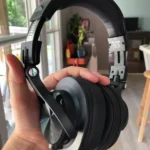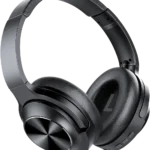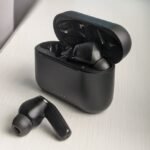Active noise canceling (ANC) technology has revolutionized the way we experience sound in our daily lives, particularly in noisy environments. In this comprehensive guide, we will delve into the world of ANC to uncover its inner workings, benefits, different types, and usage.
Whether you’re a music enthusiast, frequent traveler, or someone looking for a respite from the hustle and bustle of everyday life, understanding ANC is crucial to making informed choices about your audio equipment. So, let’s explore the fascinating world of active noise cancellation and discover how it can enhance your auditory experience. Check out our review of the TOZO HT2 Active Noise Canceling Headphones.
What Is Active Noise Canceling (ANC)?
Active Noise Canceling (ANC) is a technology used in headphones and earbuds to reduce or eliminate background noise, providing a more immersive and uninterrupted listening experience.

This innovative technology significantly enhances sound quality by isolating the listener from external noise disturbances, allowing for a more focused and serene audio experience. The frequency analysis involved in ANC is a crucial aspect, as it ensures that the generated anti-noise frequencies precisely match the incoming ambient sounds, effectively neutralizing them. By integrating ANC into headphones and earbuds, manufacturers are revolutionizing the way individuals engage with audio content, be it music, podcasts, or calls. Check out our review of the BERIBES Active Noise Canceling Headphones.
How does active noise cancellation work?
Active Noise Canceling (ANC) works by utilizing built-in microphones to capture ambient sounds, then generating inverse sound waves that effectively cancel out the external noise, creating a quieter listening environment. Leading brands such as Sony and Bose have implemented innovative ANC technologies in their headphones to deliver superior sound quality and immersive audio experiences.

When the microphones detect unwanted noise, they relay this information to a dedicated ANC processor, which then generates an anti-noise signal. This signal is mixed with the incoming audio to produce an opposite sound wave, effectively neutralizing the ambient noise.
One of the crucial aspects of ANC is the quality of microphones and sound processing algorithms. Companies like Sony and Bose have invested heavily in developing advanced microphones that can accurately capture and analyze ambient sounds, enabling precise cancellation.
These industry leaders have also integrated adaptive ANC features that adjust the cancellation level based on the surrounding environment, ensuring optimal performance in different settings. Check out our review of the OneOdio A70 Active Noise Canceling Headphones.
What Are the Benefits of Active Noise Cancellation?
The benefits of Active Noise Canceling (ANC) are multifold, encompassing enhanced sound clarity, reduced ambient noise interference, improved audio immersion, and heightened comfort during prolonged usage. ANC technology not only elevates the overall audio experience but also contributes to the ergonomic design and comfort of noise-canceling headphones and earbuds.

With ANC, listeners can enjoy crystal-clear audio without the distraction of external noise, making it ideal for both work and leisure. The elimination of background noise enables users to immerse themselves fully in their music, movies, or calls, creating a more immersive and engaging experience.
ANC promotes comfort by reducing the need to increase volume levels to compensate for environmental noise, thus preventing listening fatigue and potential hearing damage. This technology significantly enhances the overall audio experience, whether for professional use or personal enjoyment.
Reduces Background Noise
One of the primary benefits of Active Noise Canceling (ANC) is its ability to effectively reduce background noise, creating a more serene and undisturbed listening environment for users. ANC technology in headphones and earbuds actively mitigates ambient sounds, allowing listeners to focus on their audio content with minimal external disturbances.
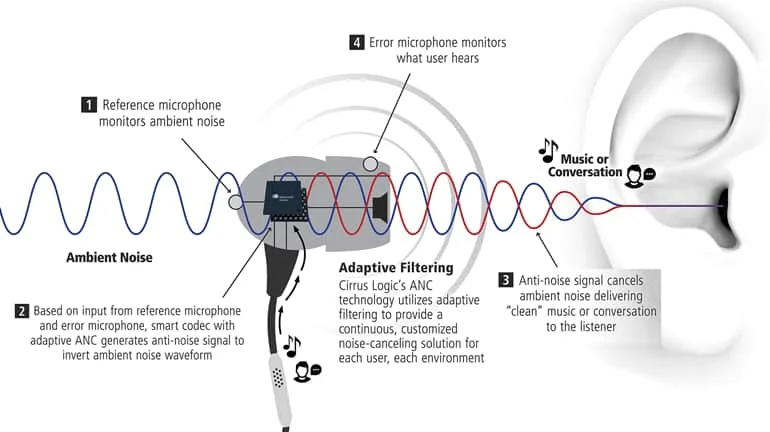
By actively analyzing and countering ambient sounds, ANC significantly improves sound clarity, making it especially beneficial in noisy environments such as airplanes, trains, or bustling city streets. The reduction in background noise enhances the listening experience, allowing for a heightened immersion in music, podcasts, or calls. ANC’s ability to filter out low-frequency sounds, like the humming of engines or air conditioning, contributes greatly to the overall comfort and quality of audio playback.
Protects Hearing
Active Noise Canceling (ANC) contributes to hearing protection by minimizing exposure to loud background noises, thereby reducing the risk of auditory fatigue and potential hearing damage. Leading manufacturers such as Sony and Bose prioritize the integration of ANC in their headphones to provide users with a comfortable and safe listening experience.
By actively analyzing and canceling out external noises, ANC technology is instrumental in creating a tranquil auditory environment for the user. This not only enhances the overall listening experience but also plays a vital role in promoting ear health. The advanced algorithms employed in ANC systems continuously adjust to ambient sounds, effectively shielding the user from loud, jarring noises without compromising audio quality.
Improves Audio Quality
Active Noise Canceling (ANC) significantly enhances audio quality by isolating desired sounds from external disturbances, resulting in a more immersive and detailed listening experience. ANC-enabled earbuds and wireless headphones leverage advanced sound processing to optimize frequency responses and maintain high sound fidelity while conserving battery life.
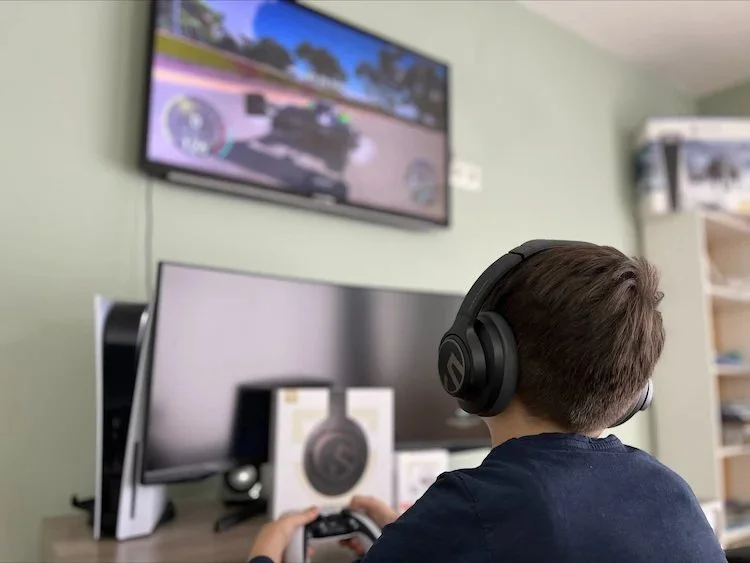
By actively identifying and neutralizing ambient noise, ANC technology allows users to enjoy their favorite music or engage in calls without the interference of surrounding distractions. This not only creates a more pleasurable listening experience but also reduces the risk of listening to music at high volumes to compensate for external noise.
With a focus on improving sound accuracy and balance, ANC systems contribute to a more natural and authentic representation of audio content, whether it’s music, podcasts, or conversations.
What Are the Different Types of Active Noise Canceling?
Active Noise Canceling (ANC) technology encompasses various types, including Feedforward ANC, Feedback ANC, and Hybrid ANC, each employing distinct methodologies to achieve noise reduction and audio isolation. Leading brands such as Sony and Bose have integrated these diverse ANC technologies into their premium headphone and earbud offerings to cater to different user preferences and environmental demands.
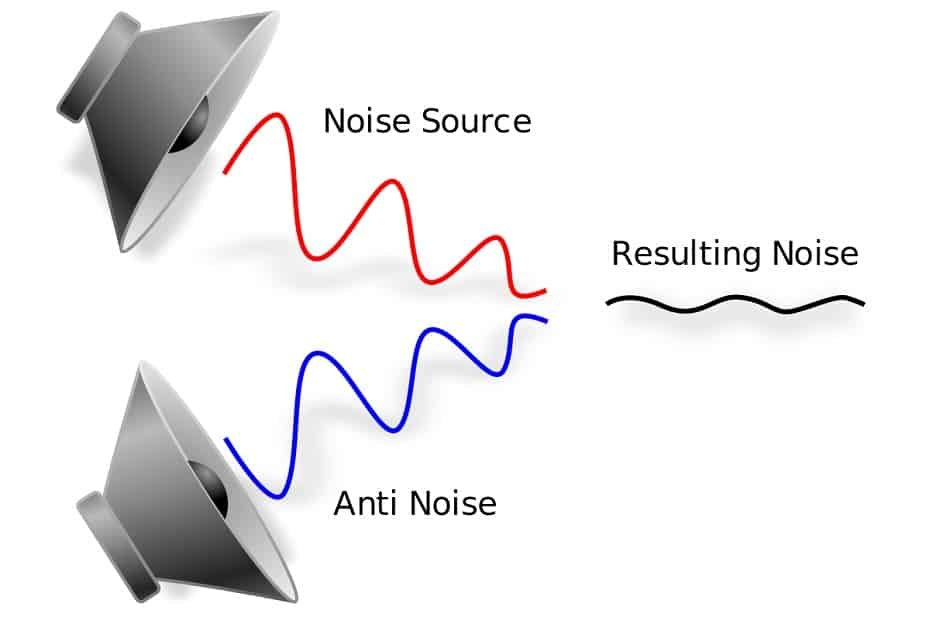
Feedforward ANC operates by capturing ambient noise through external microphones and then generating anti-noise to counteract it before reaching the ear. On the other hand, Feedback ANC detects noise within the ear cup using internal microphones and creates anti-noise signals. Meanwhile, Hybrid ANC combines elements of both feedforward and Feedback ANC to comprehensively minimize various noise frequencies. Check out our review of the MPWHYL Active Noise Cancelling Headphones.
Sony has contributed significantly to the advancement of ANC technology with the implementation of proprietary ANC systems in their flagship headphones, providing an immersive listening experience in noisy environments. Bose has also excelled in this domain, incorporating innovative ANC mechanisms that adapt to different surrounding sounds, elevating the user experience.
Hybrid ANC
Hybrid ANC technology integrates elements of both Feedforward and Feedback ANC, combining external and internal microphone systems to provide comprehensive noise cancellation and audio enhancement in wireless earbuds and headphones. The seamless integration of Hybrid ANC solutions optimizes sound quality, frequency responses, and battery performance, offering users an unparalleled listening experience in diverse environments.
By leveraging Feedforward and Feedback ANC, Hybrid ANC efficiently captures and cancels both internal and external ambient noise, resulting in an immersive and uninterrupted audio experience. This technology enables users to enjoy music, podcasts, and calls without disruptions from environmental noise.
With its sophisticated audio optimization algorithms, Hybrid ANC effectively manages frequency responses, ensuring that users experience superior sound quality across a wide range of audio content.
Another advantage of Hybrid ANC lies in its impact on battery performance. By efficiently managing the power consumption required for noise cancellation, wireless earbuds and headphones equipped with Hybrid ANC can provide extended usage time, allowing users to enjoy their favorite audio content for longer periods without the need for frequent recharging.
What Are the Differences Between Active Noise Canceling and Passive Noise Canceling?
Active Noise Canceling (ANC) and Passive Noise Canceling differ in their operational mechanisms, power requirements, noise reduction capabilities, and cost considerations.
While ANC relies on active electronic systems to counter external noise, Passive Noise Canceling utilizes physical materials and design elements to attenuate sound, leading to distinctions in power consumption, noise reduction effectiveness, and product affordability within the headphone and earbud market. Check out our review of the Picun Active Noise Cancelling Headphones.

Active Noise Canceling (ANC) headphones require built-in microphones, processors, and power sources to analyze and counteract ambient noise by generating anti-noise waves. On the other hand, Passive noise-canceling headphones use dense materials and strategic design to block out external sounds without the need for additional electronics, resulting in lower power consumption.
While ANC is highly efficient in reducing low-frequency continuous noises such as airplane engines and air conditioning, Passive Noise cancellation is most effective against high-frequency sounds like human voices and street traffic. The operational disparities between the two technologies lead to a noticeable difference in the pricing of ANC and Passive noise-canceling headphones, with ANC typically being more expensive due to its advanced electronic components.
Active Noise Canceling (ANC) headphones require an active power source, usually provided by built-in rechargeable batteries, to operate the noise cancellation circuitry and deliver uninterrupted sound isolation. Leading manufacturers such as Sony and Bose prioritize battery life optimization and efficient power management in their ANC headphone designs to ensure extended usage and enhanced user convenience.
One of the key challenges in ANC headphone design is striking a balance between delivering superior noise cancellation performance and ensuring long-lasting battery life.
Sony’s proprietary power management technology, for instance, intelligently regulates power consumption to extend the operational time of their ANC headphones, providing users with an extended listening experience.
Similarly, Bose has implemented sophisticated battery management algorithms to maximize the efficiency of their ANC headphones, contributing to longer usage on a single charge.
Active Noise Canceling (ANC) exhibits superior noise reduction capabilities compared to Passive Noise cancellation, as it actively generates anti-noise frequencies to counter external sounds, resulting in a more effective and immersive audio experience. ANC-enabled headphones and earbuds excel in isolating ambient noise and preserving sound quality across various environments, contributing to their popularity among discerning users.
This technology effectively eliminates the disruptive hum of airplane engines, the chatter of a bustling coffee shop, or the low rumble of public transportation, allowing users to immerse themselves fully in their audio content with unprecedented clarity.
One of the key advantages of ANC is its ability to enhance audio quality by reducing the need to raise volume levels to overcome external noise, thus preventing potential hearing damage while delivering a more balanced and detailed sound experience.
ANC’s ability to reduce low-frequency noise, such as the constant drone of air conditioning units or the rumble of vehicles, significantly enhances the listening experience, where clarity and immersion are essential.
Active Noise Canceling (ANC) products typically command a higher cost compared to Passive noise-canceling alternatives, reflecting the advanced technology, design intricacies, and sound optimization features integrated into ANC-enabled headphones and earbuds. Renowned brands such as Sony and Bose invest in research and development to offer premium ANC solutions, resulting in products that cater to discerning users seeking top-tier audio experiences.
This emphasis on premium positioning entails not just the cost of R&D but also the production of high-quality components and materials, as well as the integration of cutting-edge software and hardware to achieve superior noise cancellation. The implementation of state-of-the-art digital signal processing and adaptive algorithms further contributes to the heightened cost of ANC products, as industry leaders strive to deliver unparalleled audio immersion.
How to Use Active Noise Canceling Headphones?
Using Active Noise Canceling (ANC) headphones effectively involves activating the ANC feature, adjusting sound settings to suit personal preferences, and ensuring proper and comfortable headphone placement. Leading manufacturers such as Sony and Bose provide user-friendly interfaces and intuitive controls to streamline the ANC usage experience, contributing to a seamless and personalized audio environment for listeners. Check out our review of the vibeadio Active Noise Cancelling Headphones.
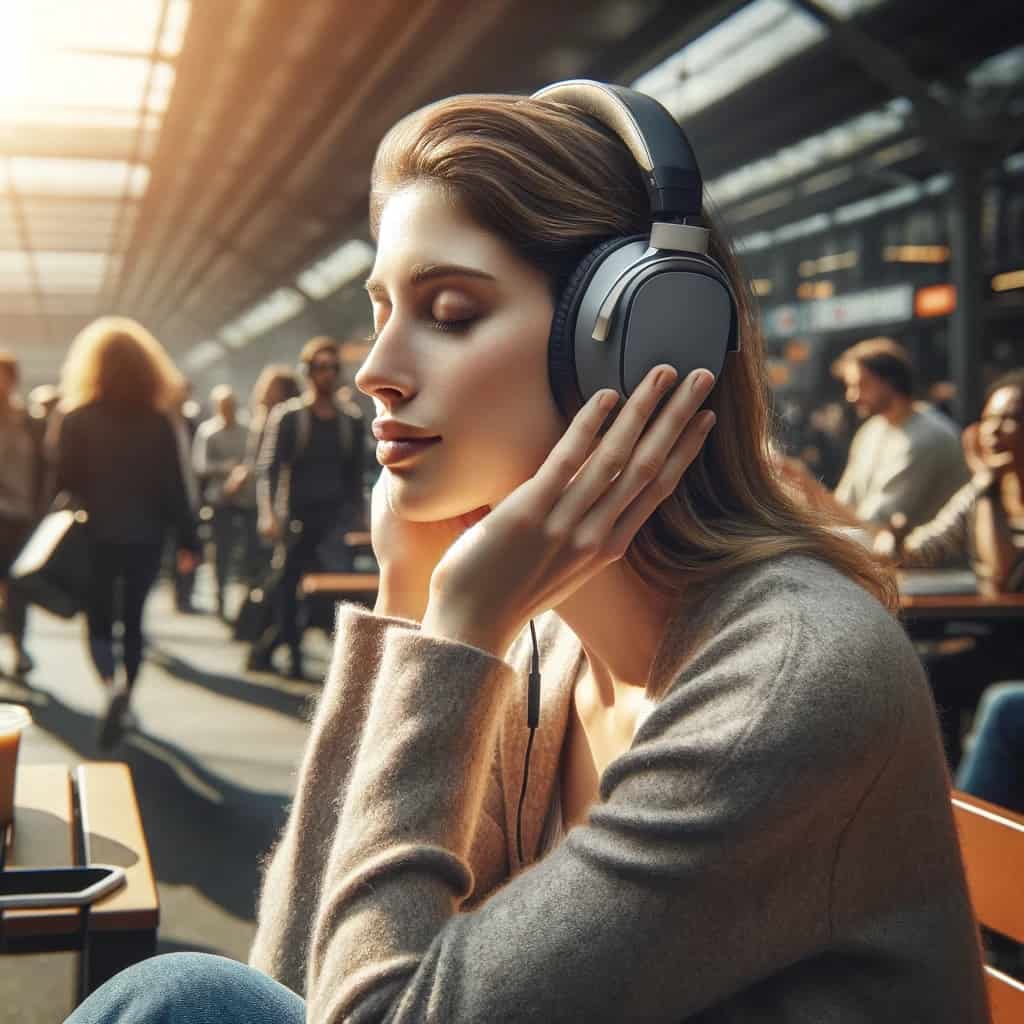
When initializing ANC headphones, first locate the ANC switch or button, often placed conspicuously on the ear cups or inline with the cable. Once activated, the headphones’ advanced technology goes to work, identifying and neutralizing external ambient sounds, allowing the user to immerse themselves in their chosen audio without distraction.
Next, take advantage of the sound adjustment features to tailor the listening experience. Both Sony and Bose offer customizable sound profiles, enabling users to adjust bass, treble, and other settings to their liking. This personalization ensures that users can enjoy their favorite music, podcasts, or movies with the optimal audio parameters for their ears.
Comfort is key when it comes to extended headphone use, and both Sony and Bose prioritize this aspect in their designs. Ensuring a proper fit and distributing weight evenly are crucial for preventing discomfort during prolonged wear, especially for travelers or office workers who rely on ANC technology to create a peaceful listening environment amidst bustling surroundings.
To enable the noise cancellation feature and start a more immersive listening experience, activate Active Noise Canceling (ANC) in headphones by accessing the designated control interface or buttons that manufacturers like Sony and Bose provide. The intuitive ANC activation mechanisms implemented by industry leaders ensure user convenience and seamless integration into headphone usage.
Once the ANC feature is available in the headphones, users can easily switch it on by pressing the dedicated ANC button or accessing the ANC settings through the headphone’s control interface. The design of these controls varies among different models, but they are generally positioned conveniently for quick access.
For instance, certain headphones have a dedicated ANC switch that users can toggle to activate or deactivate the noise cancellation. In contrast, others may require navigating the headphone’s menu or using specific buttons to engage ANC.
Regardless of the specific approach, the goal is to offer an easily accessible and straightforward process for users to enhance their auditory experience.
Users can optimize their listening experience with Active Noise Canceling (ANC) headphones by adjusting sound settings, equalization preferences, and ANC intensity levels to suit their comfort and audio immersion requirements.
The flexibility and customization options offered by ANC-enabled headphones contribute to a tailored and personalized sound environment for users, enhancing their overall audio satisfaction. By fine-tuning the sound settings, individuals can create a rich and immersive auditory journey. Adjusting the ANC intensity allows users to control the amount of external noise they want to eliminate, providing a more comfortable and personalized listening experience. These features not only give users the power to personalize their audio but also ensure that the headphones adapt to their unique hearing preferences and environmental factors.
Properly wearing Active Noise Canceling (ANC) headphones involves ensuring secure and comfortable placement on the head, with proper alignment of ear cups for optimal noise isolation and audio delivery. Industry-leading manufacturers prioritize ergonomic designs and comfort features in their ANC headphone offerings to promote extended usage and user satisfaction, emphasizing the importance of proper headphone positioning.
For instance, Sony has incorporated adjustable headbands and plush cushioning in their ANC headphones, ensuring a personalized and comfortable fit for diverse users. Additionally, Bose focuses on lightweight materials and ear cups’ rotation capability, allowing users to customize the fit based on their head shape and size.
When donning ANC headphones, it’s essential to position the ear cups directly over the ears, creating a seal to effectively block out external noise. This alignment not only maximizes the noise-canceling capabilities but also enhances audio quality, ensuring an immersive and uninterrupted listening experience.
What Are the Limitations of Active Noise Canceling?
Active Noise Canceling (ANC) exhibits limitations in dealing with high-frequency noise, potential discomfort or pressure on the ears during extended usage, and occasional impacts on sound quality, necessitating user awareness and consideration of these factors when utilizing ANC-enabled headphones.

Users may find that ANC technology struggles to effectively neutralize high-pitched, sharp sounds, such as the clatter of keyboards or the shrill of sirens, due to its focus on lower-frequency ambient sounds. Some individuals may experience a sense of pressure or discomfort, particularly during prolonged wear, which can impact the overall comfort and wearability of ANC headphones.
There can be instances where the application of ANC results in an alteration of sound quality, especially in terms of perceived bass response, leading to a potential trade-off between noise reduction and audio fidelity. These challenges highlight the importance of balancing expectations and usage scenarios when engaging with ANC technology.
Active Noise Cancelling (ANC) technology might not be very good at blocking out high-frequency noise, because the frequencies used to block out noise might not be able to block out very high-pitched sounds. This means that it should be used with care in places where high-frequency noise is common. Leading manufacturers like Sony and Bose continuously innovate to address such challenges and enhance ANC performance in diverse sound environments.
A notable challenge associated with ANC in high-frequency noise environments is the difficulty in effectively countering the rapid oscillations characteristic of high-pitched sounds. The limitation in ANC’s ability to neutralize these frequencies demands a careful approach when utilizing ANC-enabled devices in such settings, particularly in industrial or transportation environments.
Companies such as Sony and Bose have been at the forefront of developing sophisticated algorithms and systems to adapt ANC to varying sound profiles, including those with prevalent high-frequency components. By continuously refining their ANC offerings, these industry leaders strive to enhance the technology’s capacity to mitigate noise challenges across a spectrum of complex sound environments.
Due to the seal that the ear cups create for noise isolation, extended use of Active Noise Canceling (ANC) headphones may result in pressure or discomfort on the ears, necessitating breaks and adjustments for user comfort. The ergonomic design considerations and wireless capabilities integrated into ANC-enabled headphones aim to mitigate ear pressure concerns and promote extended usage comfort for users.
Long-term use of ANC headphones can cause tightness and discomfort due to the pressure the ear cups exert. This may become more pronounced during extended travel or work sessions. The seamless integration of ergonomic features, such as cushioned ear pads and adjustable headbands, ensures a snug yet comfortable fit, reducing the risk of discomfort.
The wireless functionality of modern ANC headphones allows users the freedom to move without being tethered to their audio source, providing added convenience and addressing the need for flexibility during extended use.
While Active Noise Canceling (ANC) technology excels in noise reduction, it may occasionally impact sound quality, leading to subtle alterations in audio characteristics and frequency responses, requiring careful consideration of user preferences and environmental noise levels. Industry leaders continually refine ANC implementations to minimize potential sound quality effects and preserve high-fidelity audio experiences in diverse usage scenarios.
Improvements in ANC technology are imperative as they strive to strike a balance between noise reduction and sound quality preservation. Users must discern between various ANC models, considering factors such as transparency modes and frequency response adjustments, to find the ideal device that meets their specific needs.
Industry experts are exploring advancements such as adaptive tuning and personalized calibration to attenuate any discernible impact on sound quality, ensuring that ANC technology delivers uncompromised audio performance.

